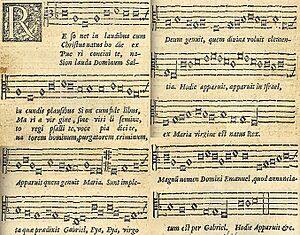Resonet in laudibus facts for kids
Resonet in laudibus is a very old Christmas carol from the 1300s. Its name means "Let the voice of praise resound" in Latin. This song was super popular all over Europe during the Middle Ages, and people still sing it today!
Contents
What is "Resonet in laudibus"?
This carol first appeared in a handwritten book called the Moosburg Gradual around 1360. After that, it showed up in many printed songbooks from the 1400s, 1500s, and 1600s. Both Catholic and Lutheran churches used it, showing how widely loved it was.
A Song Through History
There isn't just one exact version of the Latin words for Resonet in laudibus. Over time, people made many changes and new versions of the song. Some famous composers, like Orlande de Lassus and Jacobus Gallus, even created longer, more detailed musical pieces (called motets) based on it. A writer named Georg Wicel, who lived at the same time as Martin Luther (a key figure in the Protestant Reformation), called it "one of the chief Christmas songs of joy" in 1550. This shows how important it was for Christmas celebrations.
Different Versions and Translations
Besides its original Latin, Resonet in laudibus has also been translated into English. One well-known English version is "Christ was born on Christmas Day." This translation was made by John Mason Neale in 1853, who got his ideas from an old Swedish song collection called Piae Cantiones from 1582. Another English translation was done by Elizabeth Poston in 1965.
Its Melody in Other Songs
The tune of Resonet in laudibus is also used for another traditional German song called "Joseph, lieber Joseph mein," which means "Joseph dearest, Joseph mine." This song was originally a lullaby sung by the Virgin Mary in a play from the 1500s in Leipzig. These plays, called mystery plays, were popular ways to tell Bible stories. A composer named Johann Walter also used this melody to create one of his best musical pieces. More recently, Sir David Willcocks made an arrangement of the song for a collection called Carols for Choirs 2, where it's titled "Resonemus laudibus."


